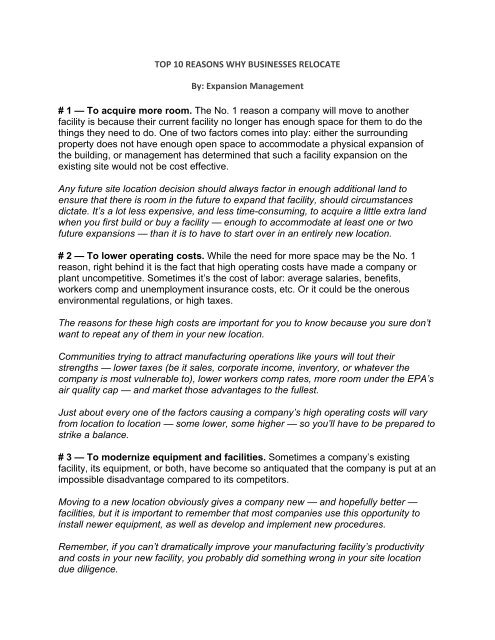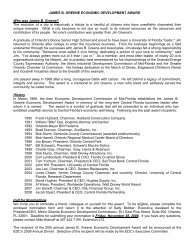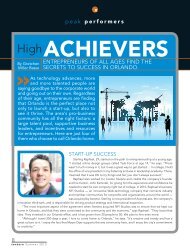TOP 10 REASONS WHY BUSINESSES RELOCATE By: Expansion ...
TOP 10 REASONS WHY BUSINESSES RELOCATE By: Expansion ...
TOP 10 REASONS WHY BUSINESSES RELOCATE By: Expansion ...
- No tags were found...
You also want an ePaper? Increase the reach of your titles
YUMPU automatically turns print PDFs into web optimized ePapers that Google loves.
<strong>TOP</strong> <strong>10</strong> <strong>REASONS</strong> <strong>WHY</strong> <strong>BUSINESSES</strong> <strong>RELOCATE</strong><strong>By</strong>: <strong>Expansion</strong> Management# 1 — To acquire more room. The No. 1 reason a company will move to anotherfacility is because their current facility no longer has enough space for them to do thethings they need to do. One of two factors comes into play: either the surroundingproperty does not have enough open space to accommodate a physical expansion ofthe building, or management has determined that such a facility expansion on theexisting site would not be cost effective.Any future site location decision should always factor in enough additional land toensure that there is room in the future to expand that facility, should circumstancesdictate. It’s a lot less expensive, and less time-consuming, to acquire a little extra landwhen you first build or buy a facility — enough to accommodate at least one or twofuture expansions — than it is to have to start over in an entirely new location.# 2 — To lower operating costs. While the need for more space may be the No. 1reason, right behind it is the fact that high operating costs have made a company orplant uncompetitive. Sometimes it’s the cost of labor: average salaries, benefits,workers comp and unemployment insurance costs, etc. Or it could be the onerousenvironmental regulations, or high taxes.The reasons for these high costs are important for you to know because you sure don’twant to repeat any of them in your new location.Communities trying to attract manufacturing operations like yours will tout theirstrengths — lower taxes (be it sales, corporate income, inventory, or whatever thecompany is most vulnerable to), lower workers comp rates, more room under the EPA’sair quality cap — and market those advantages to the fullest.Just about every one of the factors causing a company’s high operating costs will varyfrom location to location — some lower, some higher — so you’ll have to be prepared tostrike a balance.# 3 — To modernize equipment and facilities. Sometimes a company’s existingfacility, its equipment, or both, have become so antiquated that the company is put at animpossible disadvantage compared to its competitors.Moving to a new location obviously gives a company new — and hopefully better —facilities, but it is important to remember that most companies use this opportunity toinstall newer equipment, as well as develop and implement new procedures.Remember, if you can’t dramatically improve your manufacturing facility’s productivityand costs in your new facility, you probably did something wrong in your site locationdue diligence.
# 4 — To move closer to a large segment of their market, or to establish apresence in a new market. Long distances to market mean two things: time andmoney. If a significant portion of a company’s market is in a particular region, thatcompany may be able to save a lot of money in transportation costs — and also reducetheir product delivery times — by establishing an operation in that region.This is where the trade-offs really begin to kick in. Quite often, the lowest cost locationsare nowhere near the market you are trying to serve. If you need to serve the WestCoast or Northeast markets, your costs will be higher than they would be for theSoutheast or Southwest. It is what it is.If a company is striving to attract a new market, rather than simply moving closer to oneof the company’s existing markets, cost pressures on the new facility will be a lot tighter.# 5 — To consolidate into fewer facilities. Sometimes a company just has moremanufacturing facilities than it needs.This is the flip side of expansion, and is not limited to businesses in financial difficulty. Infact, it is almost always a byproduct of M&A activity, as new owners create savings byconsolidating functions and facilities.# 6 — To be closer to certain suppliers or natural resources. The same marketforces that apply to a company’s customer base also apply to its suppliers. Longdistances mean higher transportation costs and longer response times.With major manufacturers moving to just-in-time supply systems in order to savemoney, proximity to suppliers has become an increasingly critical factor. If a company isbig enough, it can simply require that the supplier(s) come to them, rather than viceversa. Raw materials are another thing altogether. Transportation and response timesare the main drivers in this instance.# 7 — To access a better or larger labor pool. These days labor is top concernexpanding or relocating companies have when they look at locations. Sometimes, acompany or facility grows to the point where the local community can no longer supply awork force in sufficient numbers and quality.Before a company starts looking at new locations, it’s important for the site locationteam to understand the work force issues in their current location. Is it a matter ofquantity ... there just aren’t enough workers to fill all the jobs? Or is it quality ... the locallabor force is not skilled enough?Whatever the reason, make darn sure that the future location offers a quantumimprovement over their current situation. After all, you don’t want to find yourself in thesame situation five years from now when your company has outgrown even its newlocation.
# 8 — To eliminate specific labor-related situations. Sometimes a company orfacility is having a bad experience with unions — recent strikes, costly benefit packages,or whatever — and the only solution is to move as far away as they can.If this is the reason a company is moving, they should make sure their due diligencegoes beyond whether or not a state is “right to work.” Two specific areas to focus on arethe history of work stoppages in the new area, and the trend in National Labor RelationsBoard representation elections (how many, and what percent are won by the union).This will enable you to better predict your future plant’s union status, say, five yearsfrom now.# 9 — To be closer to similar-type companies (clustering). Many companies like tocluster around other companies within the same industry. Silicon Valley and Detroit areclassic examples, but there are plenty of other examples all over the country.The reasons they do this are many: the work force is there, the suppliers are there, theinfrastructure is there and, most of all, companies are able to benefit from an“intellectual cross pollination” with their competitors and peers. Clustering also providesenhanced job prospects for working spouses, without creating nepotism problems.# <strong>10</strong> — To improve quality of life. Some companies just want to improve their qualityof life. This may be the personal choice of the owner for certain privately-heldcompanies, or it may be to so that the company can better attract certain types ofemployees (engineers, scientists, graphic artists or whatever) by being in “high qualityof life” location.All of us feel that the place we live has the best quality of life in the world. The importantthing is how other people perceive the quality of life in a particular location. If a companyrecruits nationally, or internationally, for high-talent employees, then being in a locationgenerally perceived to be “cool” is a definite asset.











